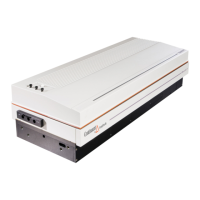37
POSSIBLE CAUSE:
Poor frequency overlap.
REMEDY:
Recheck the frequency overlap, per Section 2.2.4, to verify that the seed laser frequency laser
is not adjusted to run near a mode hop.
POSSIBLE CAUSE:
Host laser has excessive vibration or misalignment.
REMEDY:
Check the host laser for sources of vibration or misalignment, such as cooling hoses touching
the mirror mounts or the seeder support platform.
POSSIBLE CAUSE:
Lamp energy is too high.
REMEDY:
Turn down lamp joules and see if jitter improves. If energy is still at an acceptable level, then
this is the solution.
POSSIBLE CAUSE:
Photodiode receiving insufficient signal.
REMEDY:
See photodiode procedure in Symptom #1.
SYMPTOM #4: Rapid Scanning of Piezoelectric Voltage Range.
POSSIBLE CAUSE:
Water temperature unregulated.
REMEDY:
Check mechanical clamping of resonator rods to angle brackets for tightness. Check for
binding of high reflecting end mirror mount bracket on aluminum "L". If quartz resonator
rods are used, check for cracks.
SYMPTOM #5: Injection Seeder Does Not Acquire Lock Quickly.
POSSIBLE CAUSE:
Photodiode receiving insufficient signal.
REMEDY:
Check pin 6 of the Diagnositc Connector, as described for Symptom #1. The photodiode must
receive sufficient signal to be driven well into saturation.
POSSIBLE CAUSE:
Dither magnitude insufficient.
REMEDY:
Check to see that the piezoelectric tuning element is not excessively loaded due to over
tightening of high reflecting end mirror delrin endcap. Increase dither magnitude via
adjustment of the Dither Potentiometer, located on top of the laser head.

